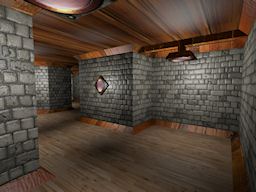More pages: 1 2
3
Geometric Post-process Anti-Aliasing
Saturday, March 12, 2011 | Permalink
I have a new demo up demonstrating a post-process antialiasing technique. Antialiasing algorithms generally come with four letter acronyms, like MSAA, SSAA, CSAA, MLAA, SRAA etc., so in that tradition I think GPAA (Geometric Post-process Anti-Aliasing) would be a decent name for this one. It works by using the actual geometric information in the scene to figure out how to blend pixels with the neighbors.
Here's a comparison before and after applying GPAA:

Henk
Tuesday, March 15, 2011
Thnx for this demo

Humus
Tuesday, March 15, 2011
zhugel_007: Well, alpha-test doesn't work with MSAA either so it's not a new problem. However, I think something like the technique I used in this demo might work:
http://www.humus.name/index.php?page=3D&ID=61
If you have the alpha-slope in screen-space you could do the same kind of smoothing as a post-process. But you'd have to render the whole surface again, not just the edges.
Rich
Tuesday, March 15, 2011
Could the technique be used on console? Any idea on performance and memory implications in comparison to Sony's MLAA?
zhugel_007
Tuesday, March 15, 2011
I agree that MSAA has the same problem since the alpha test is done per pixel rather than per sample. (Yea, I've seen your alpha to coverage demo long time ago, really nice demo.

)
Humus
Tuesday, March 15, 2011
Rich: Sure. I made this DX10 out of convenience, but it could easily be done on DX9 hardware such as consoles. I think this technique would likely come out on top over MLAA, even for full game geometry, but it would consume more memory.
Walt Donovan
Wednesday, March 16, 2011
Grats on rediscovering what I patented a long time ago! See US patent #6005580. I always thought it was a good idea myself.
Humus
Wednesday, March 16, 2011
I find the idea very appealing. Patents not so much. I'm sure it was quite a lot of work back then to come up with it, but today it just seems like good use of existing tools available in modern graphics hardware. From idea to working prototype took me a couple of hours, and from that to a complete demo just another few hours.
For someone who is not fluent in legalese, what would the legal ramification of the existence of that patent be? Has it expired by now (filed in 1996)? Would a pure shader implementation be affected (which is arguably software)? I believe software patents are still not valid in EU. Is the patent valid at all outside of the US?
anon
Friday, March 18, 2011
The patent thicket is pretty messy, and since in the US you pay quadruple damages for knowingly violating a patent vs. unknowingly, for all intents and purposes Walt has just guaranteed his technique won't get used by readers of this blog (at least American ones) until 2013 or 2016 or whenever exactly it expires.
More pages: 1 2
3




